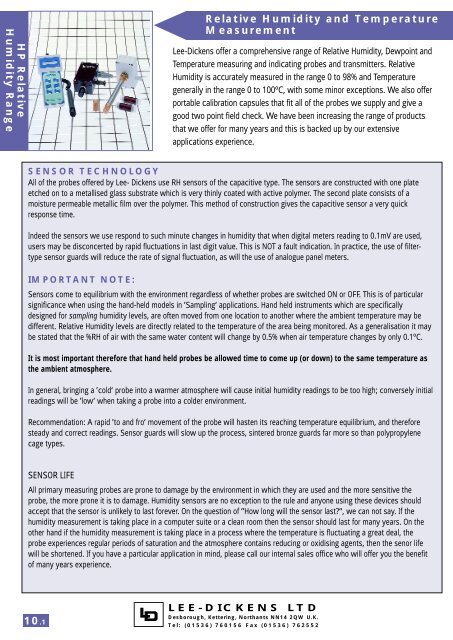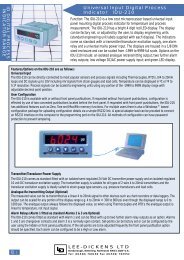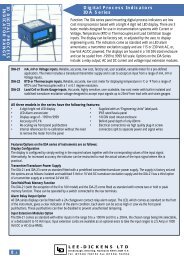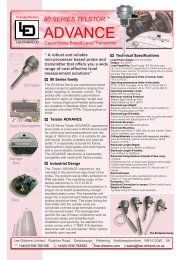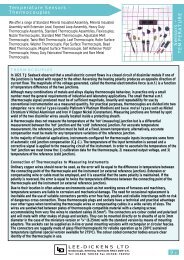10.1 Relative Humidity and Temperature ... - Lee-Dickens Ltd.
10.1 Relative Humidity and Temperature ... - Lee-Dickens Ltd.
10.1 Relative Humidity and Temperature ... - Lee-Dickens Ltd.
Create successful ePaper yourself
Turn your PDF publications into a flip-book with our unique Google optimized e-Paper software.
HP <strong>Relative</strong><br />
<strong>Humidity</strong> Range<br />
<strong>Relative</strong> <strong>Humidity</strong> <strong>and</strong> <strong>Temperature</strong><br />
Measurement<br />
<strong>Lee</strong>-<strong>Dickens</strong> offer a comprehensive range of <strong>Relative</strong> <strong>Humidity</strong>, Dewpoint <strong>and</strong><br />
<strong>Temperature</strong> measuring <strong>and</strong> indicating probes <strong>and</strong> transmitters. <strong>Relative</strong><br />
<strong>Humidity</strong> is accurately measured in the range 0 to 98% <strong>and</strong> <strong>Temperature</strong><br />
generally in the range 0 to 100ºC, with some minor exceptions. We also offer<br />
portable calibration capsules that fit all of the probes we supply <strong>and</strong> give a<br />
good two point field check. We have been increasing the range of products<br />
that we offer for many years <strong>and</strong> this is backed up by our extensive<br />
applications experience.<br />
SENSOR TECHNOLOGY<br />
All of the probes offered by <strong>Lee</strong>- <strong>Dickens</strong> use RH sensors of the capacitive type. The sensors are constructed with one plate<br />
etched on to a metallised glass substrate which is very thinly coated with active polymer. The second plate consists of a<br />
moisture permeable metallic film over the polymer. This method of construction gives the capacitive sensor a very quick<br />
response time.<br />
Indeed the sensors we use respond to such minute changes in humidity that when digital meters reading to 0.1mV are used,<br />
users may be disconcerted by rapid fluctuations in last digit value. This is NOT a fault indication. In practice, the use of filtertype<br />
sensor guards will reduce the rate of signal fluctuation, as will the use of analogue panel meters.<br />
IMPORTANT NOTE:<br />
Sensors come to equilibrium with the environment regardless of whether probes are switched ON or OFF. This is of particular<br />
significance when using the h<strong>and</strong>-held models in ’Sampling‘ applications. H<strong>and</strong> held instruments which are specifically<br />
designed for sampling humidity levels, are often moved from one location to another where the ambient temperature may be<br />
different. <strong>Relative</strong> <strong>Humidity</strong> levels are directly related to the temperature of the area being monitored. As a generalisation it may<br />
be stated that the %RH of air with the same water content will change by 0.5% when air temperature changes by only 0.1ºC.<br />
It is most important therefore that h<strong>and</strong> held probes be allowed time to come up (or down) to the same temperature as<br />
the ambient atmosphere.<br />
In general, bringing a ’cold‘ probe into a warmer atmosphere will cause initial humidity readings to be too high; conversely initial<br />
readings will be ’low‘ when taking a probe into a colder environment.<br />
Recommendation: A rapid ’to <strong>and</strong> fro‘ movement of the probe will hasten its reaching temperature equilibrium, <strong>and</strong> therefore<br />
steady <strong>and</strong> correct readings. Sensor guards will slow up the process, sintered bronze guards far more so than polypropylene<br />
cage types.<br />
SENSOR LIFE<br />
All primary measuring probes are prone to damage by the environment in which they are used <strong>and</strong> the more sensitive the<br />
probe, the more prone it is to damage. <strong>Humidity</strong> sensors are no exception to the rule <strong>and</strong> anyone using these devices should<br />
accept that the sensor is unlikely to last forever. On the question of ”How long will the sensor last?“, we can not say. If the<br />
humidity measurement is taking place in a computer suite or a clean room then the sensor should last for many years. On the<br />
other h<strong>and</strong> if the humidity measurement is taking place in a process where the temperature is fluctuating a great deal, the<br />
probe experiences regular periods of saturation <strong>and</strong> the atmosphere contains reducing or oxidising agents, then the senor life<br />
will be shortened. If you have a particular application in mind, please call our internal sales office who will offer you the benefit<br />
of many years experience.<br />
<strong>10.1</strong><br />
LEE-DICKENS LTD<br />
Desborough, Kettering, Northants NN14 2QW U.K.<br />
Tel: (01536) 760156 Fax (01536) 762552
<strong>Relative</strong> <strong>Humidity</strong> <strong>and</strong> <strong>Temperature</strong> Measurement<br />
– continued<br />
INSTRUMENT LOCATION AND RELATED FACTORS<br />
Instrument location, choice of sensor guard <strong>and</strong> attitude of probes are of paramount importance when measuring<br />
<strong>Relative</strong> <strong>Humidity</strong>. The following will give some clues as to the things to be considered prior to specifying the instrument<br />
required <strong>and</strong> the location for the installation.<br />
The first thing to note is that without forced air circulation there will exist humidity differentials across a room or chamber.<br />
There will also exist temperature differentials, which whilst normally accepted as of no consequence, will make a big<br />
difference when measuring humidity (as noted above). Therefore it will be appreciated that probe location must be<br />
considered in terms of air movement <strong>and</strong> sometimes temperature. In control applications some form of forced air<br />
movement can be anticipated, <strong>and</strong> INLETS/OUTLETS <strong>and</strong>/or MAIN/BY-PASS ducts are recommended probe locations.<br />
Users are also reminded that temperature measurement accuracy <strong>and</strong> response times must always be a function of air<br />
velocity.<br />
HP <strong>Relative</strong><br />
<strong>Humidity</strong> Range<br />
PRESSURE EFFECTS<br />
These are generally totally disregarded but are of great significance. At any given water content the %RH of air (or any gas (es))<br />
is a direct function of absolute pressure. For example the water content of air measured at 70%RH at 1050mB <strong>and</strong> 20ºC is the<br />
same as that of air measured at 77.37%RH at 950mB <strong>and</strong> the same temperature. When a probe is located within a duct, the<br />
pressure at that location relative to the chamber to be monitored/controlled should be checked.<br />
SENSOR POLLUTION<br />
In dusty, dirty, etc., conditions, it is taken for granted that a sensor guard will have been chosen. However, errors which may<br />
arise from accumulated deposits onto guards <strong>and</strong> the required guard cleaning frequency can be minimised by looking for the<br />
CLEANEST LOCATION compatible with getting results representative of the process. Sometimes this is a simple case of visual<br />
observation; other circumstances dem<strong>and</strong> a little ingenuity. For example, it is known that the upstream, central portion of a bluff<br />
body within a duct remains relatively clean – a good position for a probe.<br />
SENSOR GUARDS<br />
The <strong>Lee</strong>-<strong>Dickens</strong> range of probes can all be fitted with either a<br />
Polypropylene Cage or a Sintered Bronze Guard. The Sintered Bronze<br />
Guard (SBG) has a screening efficiency of 99% of all particles greater<br />
than 25 microns <strong>and</strong> can be used in temperatures up to 125ºC. The<br />
SBG will minimise the risk of sensor pollution with the bonus of<br />
improved mechanical protection. However, it should be borne in<br />
mind that response times will be increased, although in general this<br />
will be an insignificant effect, compatible with air velocity.<br />
Furthermore, the SBGs have a considerably greater heat-mass than<br />
the Polypropylene cages, <strong>and</strong> therefore, the latter are the preferred<br />
choice for service below 70ºC, <strong>and</strong> where little airflow is available.<br />
CONDENSATION<br />
Immersion of the sensors in clean water does not permanently alter calibration. However, condensed water must be looked<br />
upon as a very good pollutant, <strong>and</strong> steps must be taken to prevent condensed water reaching sensors. Whenever there is any<br />
risk of condensation conditions during a process cycle, or most frequently during process start-up, ensure that probes are<br />
mounted VERTICALLY, sensor-end DOWNWARD. Even copiously condensed water will then run down the outside surfaces of a<br />
probe <strong>and</strong> guard without risk of sensor contamination. Polypropylene guards are recommended when condensation is<br />
anticipated, their low thermal mass minimising drying out time.<br />
LEE-DICKENS LTD<br />
Desborough, Kettering, Northants NN14 2QW U.K.<br />
Tel: (01536) 760156 Fax (01536) 762552<br />
10.2
HP <strong>Relative</strong><br />
<strong>Humidity</strong> Range<br />
<strong>Relative</strong> <strong>Humidity</strong> <strong>and</strong> <strong>Temperature</strong> Measurement<br />
– continued<br />
SENSOR CARE<br />
In general air-borne solids are not expected to penetrate sensor filter guards, although sub-micron particles may do so.<br />
Further, accidents happen – particularly to probes with ’cage‘ type guards where the only function is mechanical protection.<br />
The sensor is very lightweight <strong>and</strong> delicate <strong>and</strong> its surface has to remain porous to permit absorption <strong>and</strong> desorption of<br />
moisture. It should therefore be appreciated that on no account should sensors be touched by even the softest materials,<br />
e.g. a sable hair brush. The following procedures are offered as a guide to cleaning if necessary, but cannot be construed to<br />
be a guaranteed process:<br />
1) Visual examination: The use of a X10 lens will assist in identifying the nature of the contamination.<br />
2) If dust is observed a squeeze bulb (as used for cleaning lenses) can be used to apply a squirt of air to remove dust. If<br />
success is not total, direct a stream of distilled water onto the sensor from a squeeze-bottle, the instrument being held<br />
sensor-end downward. Shake excess water from the sensor, <strong>and</strong> dry in a warm airstream (a hair dryer is suitable) in a dust<br />
free environment.<br />
3) If an oily pollution is observed or the treatment in 2) above is unsuccessful, apply a stream of perchlorethylene from a<br />
squeeze-bottle.<br />
4) Sensor replacement: Avoid all h<strong>and</strong>/tool to sensor contact; h<strong>and</strong>le from lead wires only, avoiding all wire-to-sensor stress.<br />
Heat sink leads properly when soldering avoiding any possibility of flux splatter onto the sensor. Use tweezers.<br />
5) CHECK CALIBRATION. It is recommended that instruments should always be check calibrated after a cleaning process has<br />
been carried out, <strong>and</strong> of course after sensor replacement. Please note that a linearity check is advisable. Occasionally, some<br />
forms of pollution cause loss of linearity.<br />
SENSOR DAMAGE DIAGNOSIS<br />
Visual examination before/after cleaning may reveal inadvertent mechanical damage. As a generalisation, this would result in<br />
low readings through loss of capacitance. In this event, sensor replacement is indicated. The presence of non-hygroscopic<br />
deposits will tend to increase capacitance <strong>and</strong> therefore signal output. Hygroscopic materials will act similarly but to a greater<br />
extent. A very high reading, from your probe/transmitter is likely to indicate partial/total polymer dielectric breakdown. In this<br />
event, sensor replacement is necessary.<br />
SENSOR FILTER GUARD CLEANING<br />
Hard <strong>and</strong> fast rules cannot be provided regarding cleaning frequency – this must be dictated by operating conditions <strong>and</strong><br />
commonsense, backed up by periodic visual examination. The danger of insufficient cleaning/replacement of guards is threefold:<br />
1) The guard may become significantly obstructed<br />
2) The materials build-up may be of such nature as to increase or reduce %RH readings<br />
3) Excessive corrosion product build up on bronze guards may increase the danger of sensor pollution under saturation<br />
conditions<br />
REMOVAL OF SENSOR GUARDS<br />
When removing guards ALWAYS ensure that the final guard separation from the probe is effected co-axially, preventing any<br />
contact with the sensor.<br />
Cleaning is best effected by applying a clean air-blast into the hollow portion of the guard <strong>and</strong>/or similarly applying a hose<br />
connected to a mains water supply. In the latter case, dry guards thoroughly, polypropylene at 70ºC max, bronze guards at up<br />
to 150ºC. Fatty materials are best removed by suitable solvents such as trichlor or perchlor ethylene or ’freon‘-type solvents.<br />
CAUTION: NEVER use any kind of detergent or surfactant. It is unlikely that all traces can be removed <strong>and</strong> non-linearity of<br />
readings will result.<br />
10.3<br />
LEE-DICKENS LTD<br />
Desborough, Kettering, Northants NN14 2QW U.K.<br />
Tel: (01536) 760156 Fax (01536) 762552


